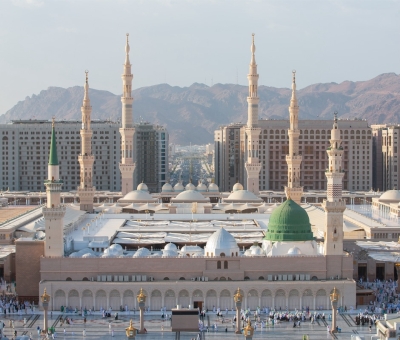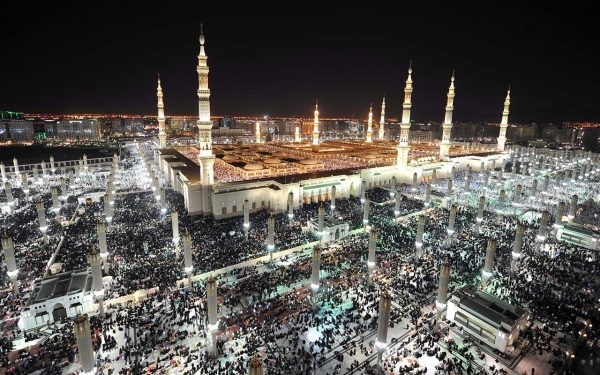
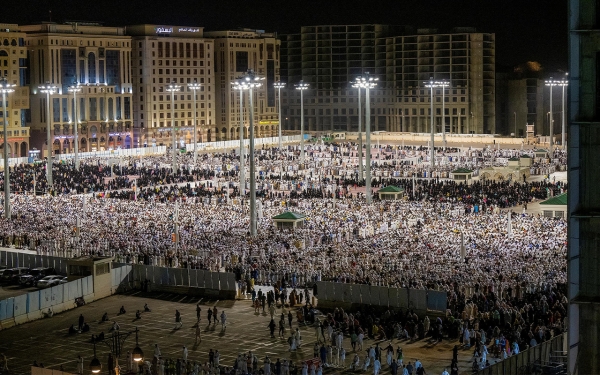
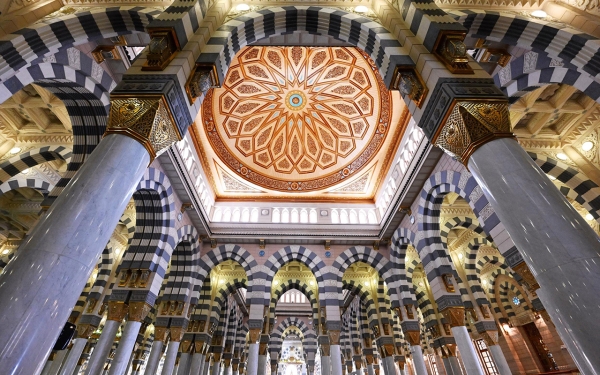
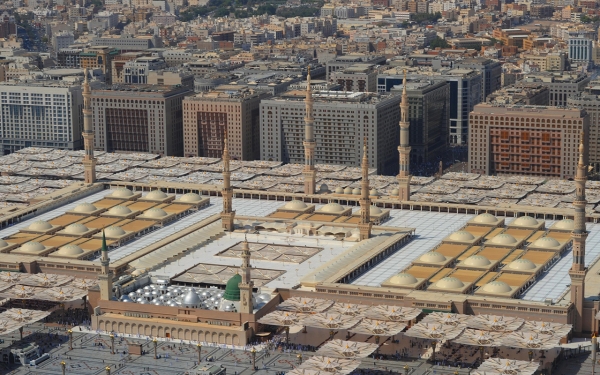
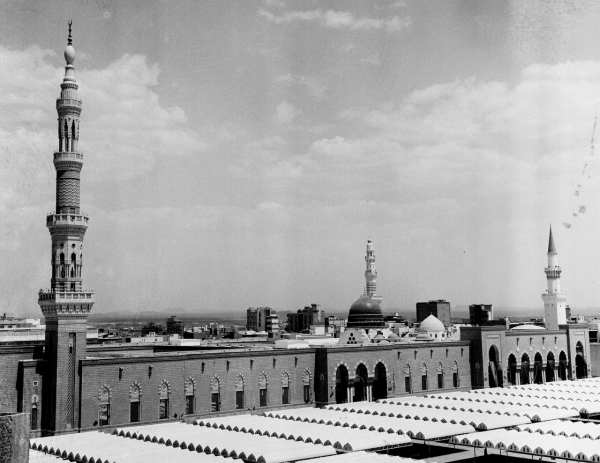
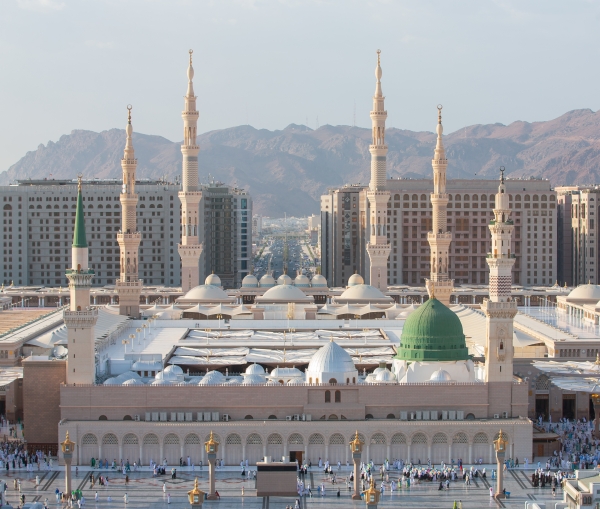
The Prophet's Mosque is the Mosque of Prophet Muhammed, peace be upon him (PBUH), the last mosque of the prophets, the best mosque after the Grand Mosque, the second of the Two Holy Mosques, and the second most sacred religious site for Muslims after the Grand Mosque. The Prophet's minbar and mihrab (where the Imam stands to lead the prayer) lie in the Prophet's Mosque. Furthermore, the call to Islam was launched from this mosque.
The significance of the Prophet's Mosque
The importance of the Prophet's Mosque (PBUH) lies in its characteristics. The reward for praying in the Prophet's Mosque is one thousand times more than that of any other mosque, with the exception of the Grand Mosque. Moreover, it is one of the three mosques to which people aspire to travel for worship because of its great virtue and status before Allah Almighty. The Prophet's Mosque also contains al-Rawdah al-Sharifa, one of the gardens of heaven, as told by the Prophet (PBUH), in addition to prominent landmarks in the history of Islam that attract visitors from around the world throughout the year, such as: the Noble Prophet's Chambers and Grave, its mihrab and minbar, al-Rawdah al-Sharifa, its pillars, and the Green Dome.
The location of the Prophet's Mosque
The Prophet's Mosque is located in al-Madinah al-Munawwarah, west of the Kingdom of Saudi Arabia. The General Authority for the Affairs of the Two Holy Mosques (formerly known as the General Presidency for the Affairs of the Grand Mosque and the Prophet's Mosque) has been looking after the religious affairs and services of the Prophet's Mosque and the Grand Mosque since 1977, in addition to providing all facilities for the comfort of its visitors.
The expansion of the Prophet's Mosque
The Prophet's Mosque witnessed its first expansion in the year 628 by the Prophet (PBUH) after his arrival from Khaybar with an increase of 1,425 m in its size, thus doubling to 2,475 m. Al-Madinah al-Nabawiya was built around it, and its architecture and construction were subject to much attention from caliphs and kings throughout the ages. Furthermore, Umar Ibn al-Khattab (may Allah be pleased with him) continued with the expansion in the year 638 by adding 1,100 m to its area, followed by Uthman Ibn Affan (May Allah be pleased with him) who also added 496 m in the year 649-650. During the era of the Umayyad dynasty, the area of the Prophet’s Mosque was increased to 2,369 m by al-Walid Ibn Abd al-Malik between 706 and 709. The expansion continued during the era of the Abbasid state between 777 and 781, reaching 2,450 m during the Mahdi era. Finally, the area increased by 120 m in the hands of Sultan al-Ashraf Qaitbay in 1483, marking the last of the mosque's expansions before the Saudi era by the Ottoman Sultan Abdulmejid between 1848 and 1860, with an increase of 1,293 m.
Architecture of the Prophet’s Mosque
The Prophet’s Mosque was distinguished in its construction by its pillars, minarets, gates, and external courtyards surrounding this structure, which witnessed an evident change over the ages, in terms of shape, size, and area. The mosque witnessed several expansion, development, and increase projects, while trying to preserve its architectural features, most notably:
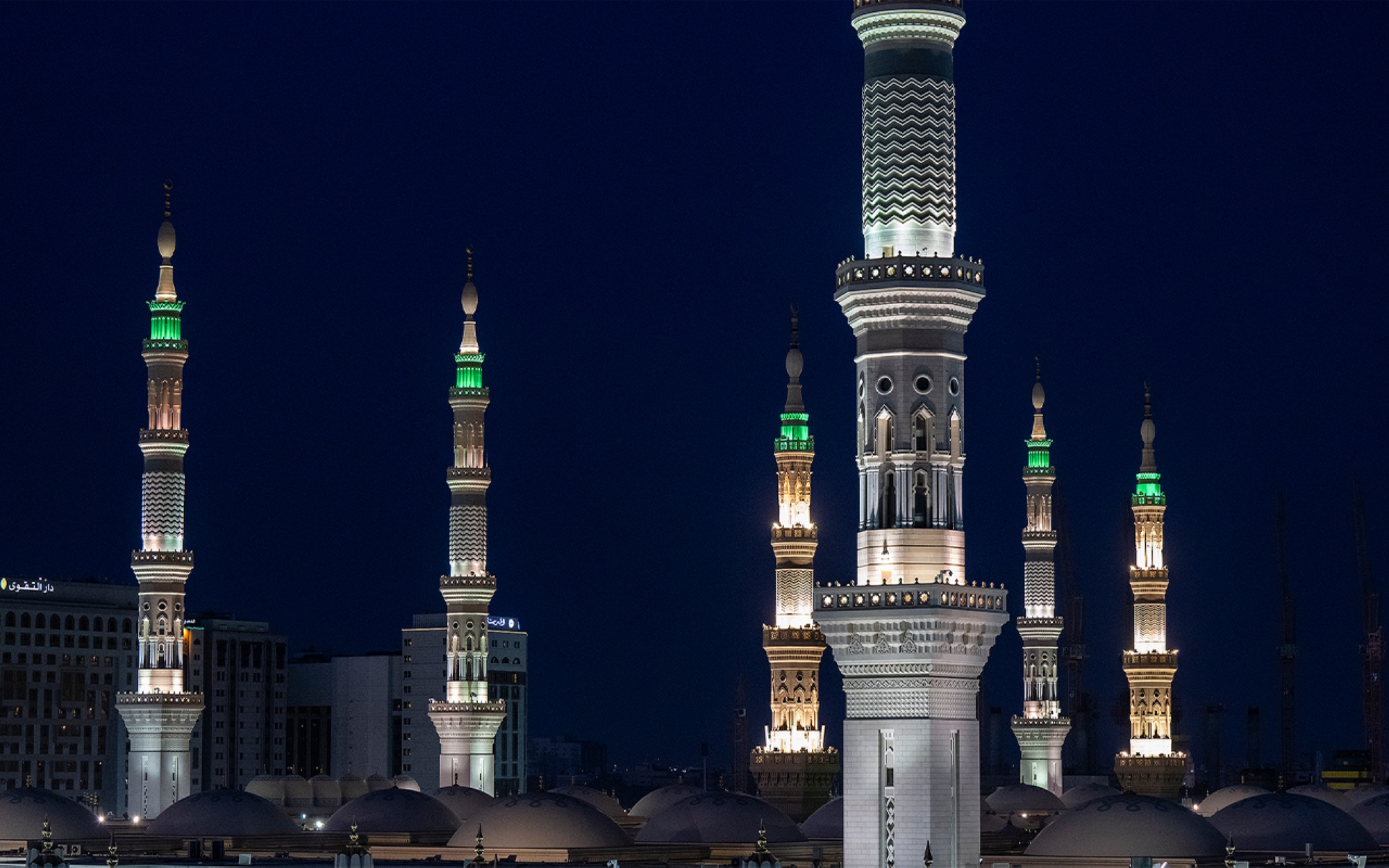
The minarets of the Prophet's Mosque
Before the Saudi era, the Prophet’s Mosque did not have minarets on which the muezzin could ascend and give the call to prayer during the era of the Prophet (PBUH) nor during the era of his Rightly Guided Caliphs. Bilal Ibn Rabah (May Allah be pleased with him) used to give the call to Fajr prayer from above the house of a woman from Banu Najjar, as her house was the tallest one around the mosque. It was said that Bilal would ascend on the pillar of Abd Allah Ibn Umar (may Allah be pleased with them) by taking seven stairs near the Prophet's Mosque. The first minaret was built during the reign of Umar Ibn Abd al-Aziz during al-Walid Ibn Abd al-Malik's expansion of the Prophet’s Mosque. He placed a minaret in every corner of the mosque, one of which was later demolished. During the reign of Sultan al-Ashraf Qaitbay, he built a small minaret between Bab al-Salam (the Door of Peace) and Bab al-Rahmah (the Door of Mercy), which was later known as Bab al-Rahmah Minaret. After the expansion of Sultan Abdulmejid, the Prophet’s Mosque had five minarets: the northwestern minaret, the northeastern minaret, and the western minaret, which were replaced in Saudi architecture with larger and more beautiful minarets, in addition to the southeast minaret and the southwest minaret, which have preserved the same structure and are subject to occasional restorations by the Saudi government.
In the Saudi era, the Prophet’s Mosque had four minarets during the first Saudi expansion. The northwest and the northeastern minarets, as well as Bab al-Rahmah Minaret, were replaced by one on the northeastern side and the other on the northwestern side. During the Saudi expansion, minarets were seventeen m deep and seventy m high. They consisted of four floors of different shapes: the first was square-shaped, the second was octagonal, the third was round, and the fourth ended in a conical shape topped with a dome. During the second expansion, six new minarets were added to the Prophet’s Mosque, which consisted of five floors, reaching a depth of 50.45 m and a height of 104 m, which is thirty-two m more than the minarets of the first Saudi expansion, bringing the total number of minarets to ten throughout the entire period of the expansion.
The mosque's minaret and its Green Dome are symbols of the Prophet's City. The south-eastern minaret was sixty m high. The building of the first minaret (which was called Manara in Arabic) is associated with Caliph Umar Ibn Abd al-Aziz, who was instructed by al-Walid Ibn Abd al-Malik to erect a minaret in every corner of the mosque. Currently, the mosque has ten minarets which are seventy and 104 m high.
The doors of the Prophet's Mosque
The first construction of the Prophet’s Mosque included three main doors whose names remained the same. There is a door in the back of the mosque, facing the current direction of the Qiblah. At the time, the Qiblah was facing Jerusalem. After turning the Qiblah towards al-Kaaba al-Musharrafa, the door in the southern wall was closed, and was replaced by a door in the northern wall. Three riwaqs (porticoes) were created on the south side, similar to those on the north side. Moreover, Bab Othman and another door on the western side called Bab Atika (currently known as Bab al-Rahmah) remained in the mosque. Bab Atika took its name from a woman from Makkah called Atika, the daughter of Zayd Ibn ʿUmar, from the clan of Banu Adi, who converted to Islam and immigrated to al-Madinah al-Munawwarah, and whose home was opposing the mosque. Moreover, it was also known as Bab al-Souk (Door of the Market) because it led to the market. As for its name Bab al-Rahma, it is mentioned in Sahih al-Bukhari that it rained for seven days after a man entered the mosque and asked the Prophet (PBUH) for rain. The next week, that same man prayed that the rain would stop to avoid drowning. Consequently, the sky cleared, and this event was seen as an act of mercy, thus its name Bab al-Rahmah (the Door of Mercy). Moreover, it was also named the Door of the Prophet, because the Prophet (PBUH) used it to enter the mosque. Finally, the third door is located on the eastern side and was known as Bab Uthman because the mosque was located in front of the house of Uthman Bin Affan.
After the expansion of Umar Ibn al-Khattab (May Allah be pleased with him), the mosque had six doors, i.e., three new doors were added to the existing doors that were in the walls of the mosque during the era of the Prophet (PBUH). Consequently, two doors were installed in each of the northern, eastern, and western walls. The number of doors in the Prophet’s Mosque continued to increase during its expansion throughout history until they reached one hundred external doors, while the total number of internal and external doors amounted to 229.
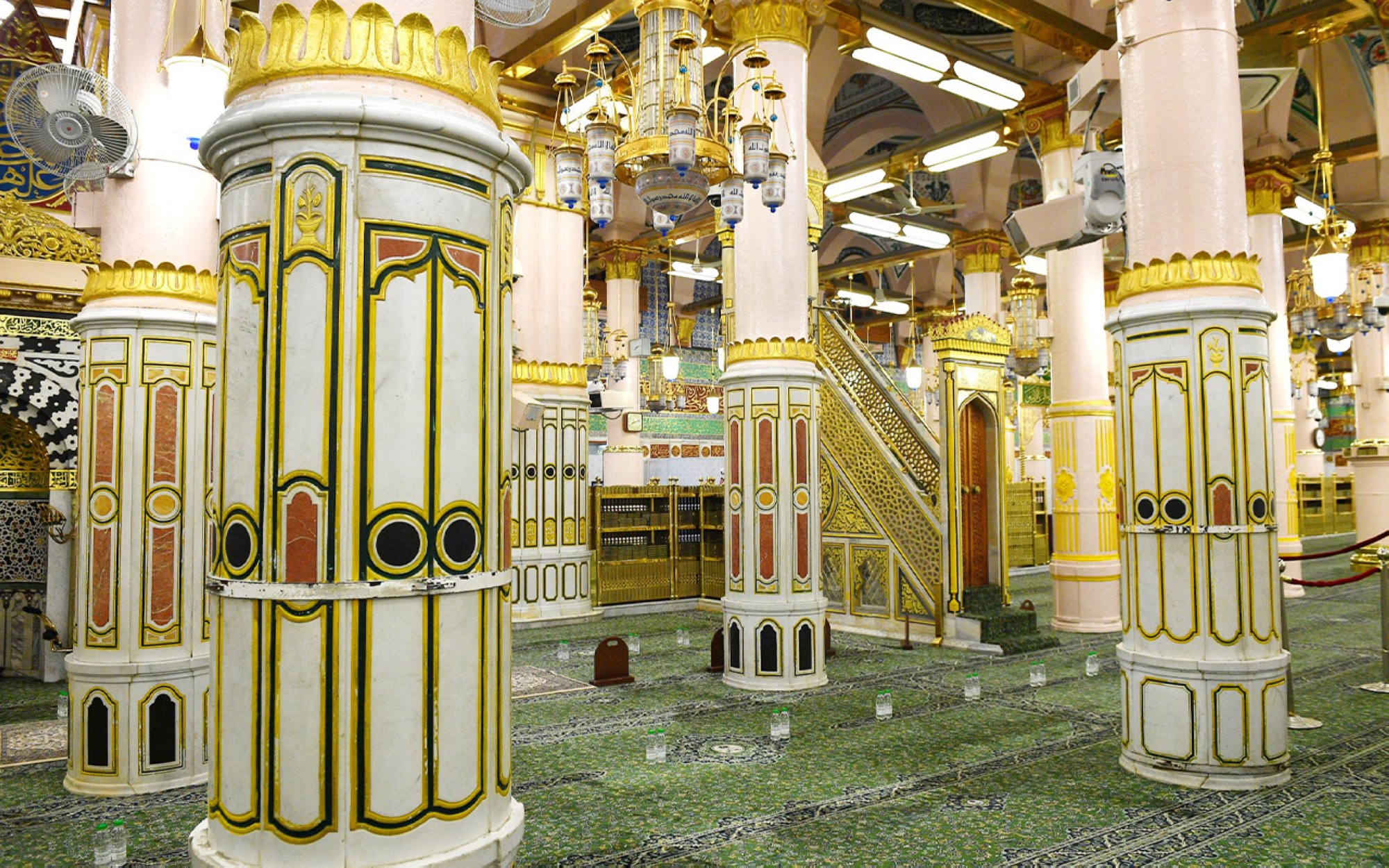
Pillars of the Prophet's Mosque
In Arabic, assateen, the plural form of ustuwanah, refers to the pillars and columns that serve as the foundation for structures. During the reign of the Prophet (PBUH), the pillars of the mosque were made of palm trunks. If a name was given to a column, it refers to the pole that replaced it. Those who expanded the Prophet's Mosque made sure to preserve the locations of these pillars. Therefore, each column was placed in the same location as that of the pillar or pole during the era of the Prophet (PBUH). The pillars, which are situated in the Qiblah section of the Prophet’s Mosque, were erected during the expansion of Sultan Abdulmejid. Eight of these pillars became famous, as they enjoyed unique characteristics. These pillars are:
The Pillar of Mukhallaq, also known as the Prophet's (PBUH) prayer place. In Arabic, the term mukhallaq means perfume or fragrance. It is said that Uthman Bin Maz'oon accidentally spit in the mosque, and became depressed. 'Why are you depressed?' his wife asked. He answered, 'It is nothing, I spit on the Qiblah while praying.” Then, his wife washed and aromatized the Qiblah, thus becoming the first person to do so. This pillar was slightly moved towards the Qiblah, and some of its parts were inserted into the Prophet's Mihrab. Its name The Pillar of Mukhallaq was inscribed on the pillar.
The Pillar of al-Qur’ah: It is the third from the minbar, the third from the grave, and the third from the Qiblah. Its name is derived from the accounts of Aisha (may Allah be pleased with her) who reported that the Prophet said, In this mosque, there is a place near this pillar, if people were to know about (its secret) they would draw lots to be able to pray there. When people looked at its location, several companions and travelers were standing in that same spot, the pillar of al-Qur'ah.
The Pillar of Tawbah, the fourth pillar of the minbar, the second from the grave, and the third from the Qiblah. It was called after Abu Lubabah. When Banu Quraizah conferred with him as their ally on whether to submit to the rule of the Prophet (PBUH), his answer was yes, and made a sign across his throat, as to indicate death. He then realized that by performing this act, he had been unfaithful and disloyal to Allah and the Prophet, and it was on this occasion that the following verse was revealed: 'O ye that believe! Betray not the trust of Allah and the Messenger, nor misappropriate knowingly things entrusted to you (Surah al-Anfal, Verse 27). He did not return to the Prophet (PBUH) but went to the mosque, tied himself where the Pillar of Tawbah is now located, and swore that as long as his repentance is not accepted by Allah, he nor anyone else would release him, except for the Prophet (PBUH). When the Prophet heard this, he was reported to have said, 'If he had come to me, I would have begged forgiveness on his behalf. Now he had acted on his own initiative, I cannot untie him until his repentance has been accepted.” After these events, Allah revealed his repentance to the Prophet (PBUH) at the house of Umm Salamah, may Allah be pleased with her, who heard the Prophet laugh, and asked him if Allah was amusing him. The Prophet said, 'Abu Lubabah’s repentance has been accepted.' 'Do I have your permission to inform him of the good news?', Umm Salamah asked. “You may if you wish,” he answered. She stood from inside the room, before the Hijab was imposed on them, and said, 'O’ Abu Lubabah! Allah has accepted your repentance.” When the Muslims wanted to untie him, Abu Lubabah said, 'I place you under the oath of Allah that none, except the Prophet, should untie me.” When the Prophet passed by him while heading to perform the morning prayers, he untied Abu Lubabah, thus the name The Pillar of Tawbah.
The Pillar of Sareer is located east of the Pillar of Tawbah, and sticks to the window overlooking al-Rawdah al-Sharifa. It is reported that this is the place where the Prophet (PBUH) would perform i’tikaaf, which is to be in isolation in a mosque or at home with the intention of solely dedicating your time to the worship of Allah. The Prophet (PBUH) had placed a bed made of palm leaves and a pillow there in order to lie next to the pillar.
The Pillar of al-Mahras, located behind the Pillar of Sareer from the north, and opposing the door from which the Prophet (PBUH) would use to exit the house of Aisha, may Allah be pleased with her, in order to reach al-Rawdah al-Sharifa to pray. Moreover, it was also called the Pillar of Ali Ibn Abi Talib because this is where he would sit to guard the Prophet (PBUH).
The Pillar of Wufood, located behind the Pillar of al-Mahras from the north. The Prophet (PBUH) would sit there to meet with groups of Arabs. It was also known as Majlis al-Qiladah, where the Companions and their seniors, may Allah be pleased with them, would sit.
The Pillar of Muraba'at al-Qabr, located on the wall of Umar Ibn Abd al-Aziz, may Allah be pleased with him, from the western wall to the north, within the same row as the Pillar of Wufood. It is situated within the wall surrounding the Grave, which means that it is inaccessible to visitors. It is also known as the Pillar of Jibraeel (PBUH), and its location includes the door of Fatima's house, the daughter of the Prophet (PBUH), from which Ali Bin Abi Talib would enter.
The Pillar of Tahajjud, located behind the house of Fatima, the daughter of the Prophet (PBUH), from the north. If visitors stand next to the small mihrab on that location, the pillar would be on their left, in the direction of the Door of Jibraeel, previously known as the Door of Uthman, may Allah be pleased with him. The following phrase was inscribed on a piece of marble: This Is the Prophet's (PBUH) Place of Tahajjud.
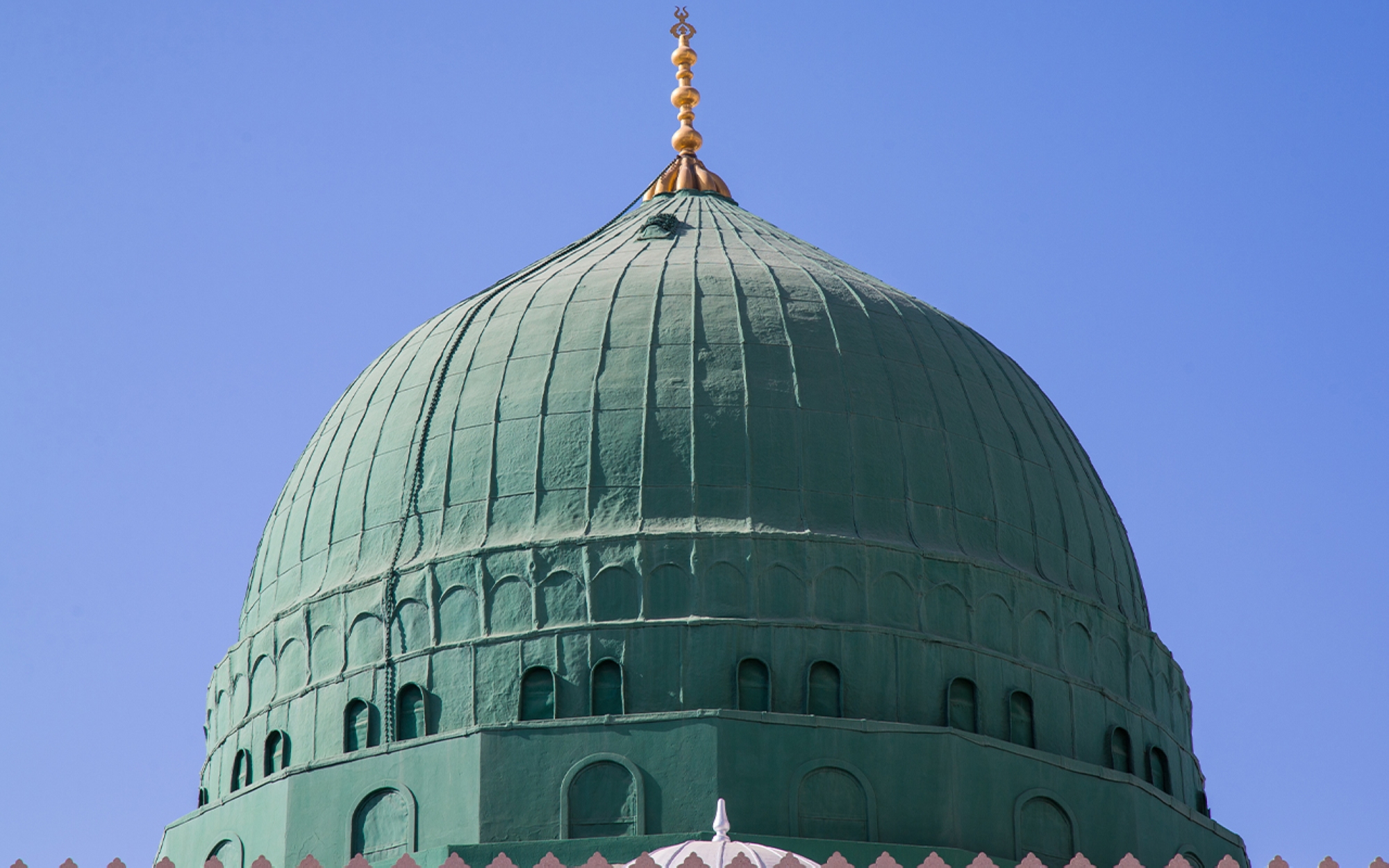
Green Dome
The Green Dome is known by a number of names, including: the Fragrant Dome, the Blue Dome, the White Dome, the Dome of al-Madinah, or the Prophet's Dome. It is the dome built on the Prophet’s Chamber located inside the Prophet’s Mosque, specifically over the chamber of the Mother of the Believers, Aisha, may Allah be pleased with her. The dome received much attention and care from the guardians of the Two Holy Mosques. It is subject to improvement and restoration every three to five years. Its importance lies in the fact that the tomb of the Prophet (PBUH) is located beneath the dome. The Green Dome does not go back to the era of the Companions or the followers but was built in 1279. It is square-shaped from the bottom, and octagonal at the top. It was made of wood, and built on top of the pillars that surrounded the chamber. Plates of lead were nailed to the wooden structure and were covered with plaster. In 1837, Sultan Abd al-Hameed ordered the dome to be painted green instead of blue, thus becoming the first ruler to paint green. Since then, the dome has been repainted in green whenever needed. In the Saudi era, during the time of the Founding King Abdulaziz Al Saud, some cracks and breaks were repaired inside the Prophet’s Chamber, and the dome became as stunning as ever.
Parts of the Prophet's Mosque
The Prophet’s Mosque contains parts that distinguish it from the rest of the mosques, including the Prophet's minbar, the Noble Prophet’s Chamber, al-Rawdah al-Sharifa, the mihrab, and the library. Most of them have undergone a number of reforms, expansions, and developments over the ages.
The Prophet's minbar
The minbar is the elevated platform within the mosque from which the preacher delivers their sermon. It began when the Prophet (PBUH) would deliver his sermon by leaning on the trunk of a palm tree that was placed in the mosque. When it became difficult for him to stand, a three-stairs minbar was designed for him and placed on the western side of his prayer area. He used to sit on it and preach to the people, while everyone around him could see him. The Prophet's (PBUH) minbar was made of tamarisk or 'athl' wood which was brought by the carpenter. During the era of the Prophet (PBUH) and his Rightly Guided Caliphs, the minbar consisted of two stairs and one seat. When the rule was passed to the Umayyad dynasty, six stairs were added to the minbar, bringing the total number of stairs to nine. It was first renewed in the era of the Abbasid state because it was starting to decay. In 1258, the King of Yemen, al-Malik al-Muzaffar, sent a new minbar because the old one was ruined when the Prophet’s Mosque burnt during that same year. In 1266, al-Zahir Baybars al-Band Qadari decided to remove it and replace it with a new minbar, which was used until it eroded. In 1417, Al-Mu'ayyad Shaykh sent a new minbar, which burnt when the Prophet's Mosque caught fire in 1481. The people of the city built a minbar made of bricks and painted with lime mortar, which was replaced by al-Ashraf Qaitbay with a marble minbar in 1483. Finally, between 1589 and 1590, the Ottoman Sultan Murad III sent an engraved and decorated minbar made of marble and painted with gold water. It consists of twelve stairs, three outside the door and nine inside, and is topped by a pyramidal dome supported by four columns. This minbar is the one used in the Prophet's Mosque today.
The Prophet’s Chamber
It refers to the home of the Prophet (PBUH) where he lived with the Mothers of the Believers, Aisha, the daughter of Abu Bakr al-Siddiq, may Allah be pleased with them. It was built by the Prophet (PBUH) when he arrived in al-Madinah al-Munawwarah and built his noble mosque. The chamber is located east of the Prophet’s Mosque, and its door opened to al-Rawdah al-Sharifa. The chamber consists of a room and a cubicle. The room is the roofed house where the Prophet (PBUH) lived and spent the night with his wife Aisha, may Allah be pleased with her. Its southern side is 4.9 m long, its northern side is 5.24 m long, and both the western and eastern sides are 3.5 m long. The room covers a total area of 17.75 m and is two m high. As for the cubicle, it is an unroofed space located in front of the door of the room and has its own door. Its northern and southern sides are 5.24 m long each, its eastern and western sides are 2.5 m long each, and its wall is 1.6 m long. The Prophet (PBUH) was buried in the house of Aisha, may Allah be pleased with her, alongside his two companions Abu Bakr and Umar, may Allah be pleased with them.
The library
The first library in the Prophet’s Mosque was constructed before the mosque caught fire in 1481. The author of Treasures of Arabic Books states that it contained Qurans and valuable books. The current library was established in 1933, on the recommendation of Obaid Madani, the Director of Endowments in al-Madinah al-Munawwarah at the time. The library contains some books which were placed in the Prophet’s Mosque before the library was established. All visitors of the Prophet’s Mosque have access to the library and its services. It is located within the mosque and includes three halls for men, women, and children. It also encompasses a manuscripts section, located on the second floor of Uthman Bin Affan Door, may Allah be pleased with him, at the end of the section reserved for the first Saudi expansion. The technical section concerned with binding, restoring, and sterilizing manuscripts, is affiliated with the manuscripts section and can be accessed through Door (22) at the section reserved for King Fahd Bin Abdulaziz Expansion. The library also includes a section for audio files to document the lessons, sermons, and prayers given within the Prophet’s Mosque. This section can be accessed through Gate (17). Other sections include: the rare books section; the cataloging, classification, and supply section; the periodicals and repository section; the digital library section; the research, translation, security and safety section; the gift and exchange section; and the borrowing section.
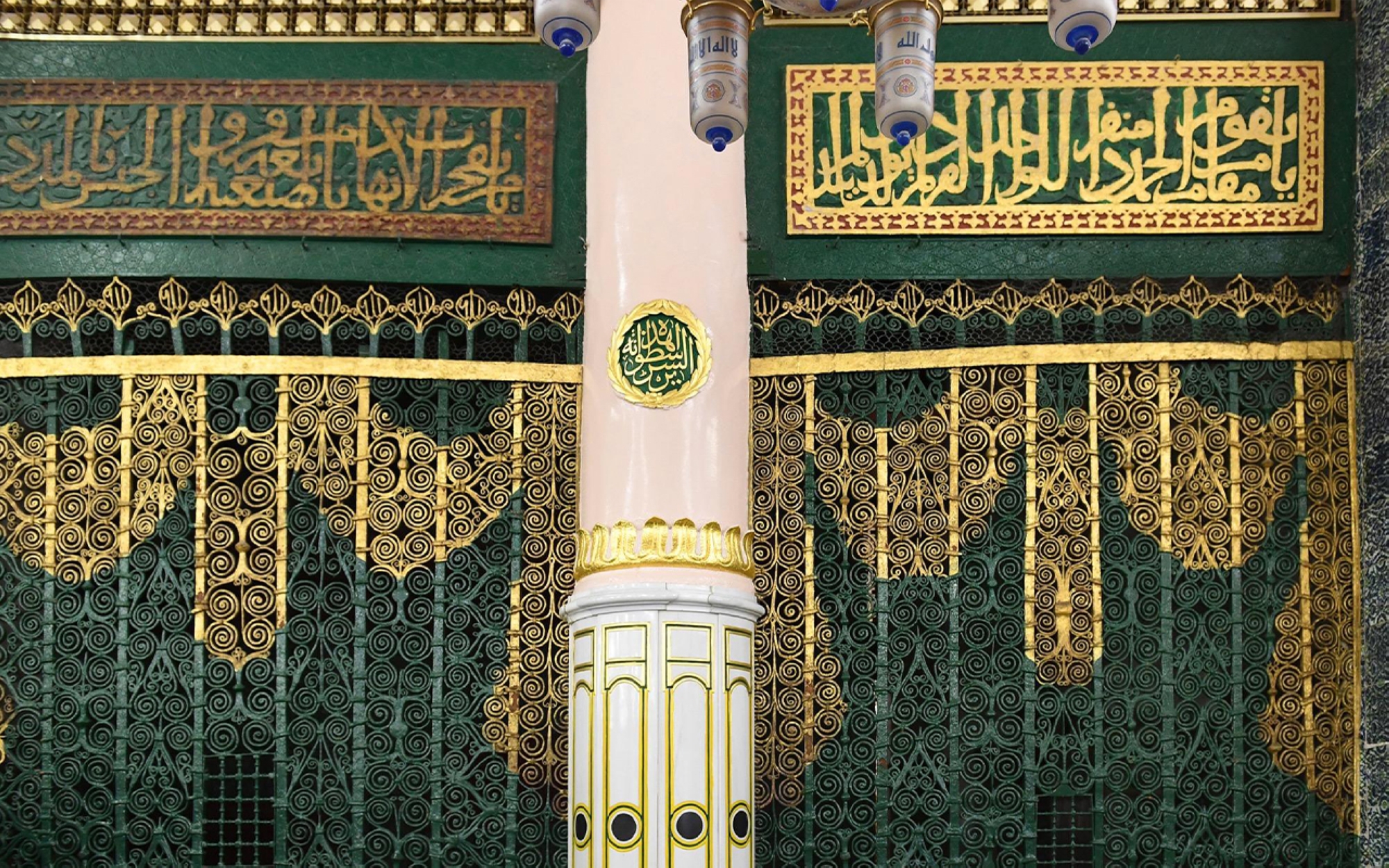
Rawda
It refers to the place located between the house of the Prophet (PBUH), which is Aisha's home, may Allah be pleased with her, and the Prophet's minbar. Rawda's name is derived from the saying of the Prophet (PBUH): The area between my house and my minbar is one of the gardens of Paradise. Many hadiths confirm the great virtue of Rawda, and performing worship at the honorable location. Prayer in al-Rawda al-Sharifa outperforms any other location in the mosque, except for the written prayer (salat), since it is a first-row prayer. Other rows performed in the Rawda are also the best prayers. According to historians, the house of Aisha, may Allah be pleased with her, is located east of the Rawda, while the Prophet's minbar is situated to the west, the Qiblah to the south, and the parallel line to the end of Aisha’s house to the north. The Rawda is rectangular in shape, and measures 26.5 m in length. The grille surrounding the chamber obscured part of the Rawdah, as it concealed the riwaq (porticoe) between the pillars that were attached to the grille surrounding the chamber. Consequently, the length of the Rawda is twenty-two m. The width of al-Rawda al-Sharifa, from the beginning of the chamber to the Pillar of Wufood, equals three riwaqs (porticoes), and their equivalent to the west, i.e., approximately fifteen m. Based on the above, the total area of al-Rawda al-Sharifa, including the part that was obscured by the grille surrounding the chamber, is 397.5 m.
The mihrab
The mihrab is known as the place of the imam in the mosque. Al-Mihrab al-Nabawi is the spot from which the Prophet (PBUH) used to pray. During the expansion of Umar Ibn al-Khattab, may Allah be pleased with him, the imam’s mihrab was moved to the far south. During the expansion of Uthman, may Allah be pleased with him, an Ottoman niche was built, which acts as the functional mihrab where the imam currently stands. The Prophet's Mosque never had a hollow mihrab, neither during the era of the prophet (PBUH) nor during the era of the Rightly Guided Caliphs. Historical sources indicate that the first hollow mihrab was discovered during the reign of al-Walid Ibn Abd al-Malik al-Umayyad between 707 and 710. Muslims paid great attention to mihrabs when they used them in mosques. They decorated them with Islamic inscriptions and engraved them with Quranic verses to reflect a purely Islamic image. Moreover, they placed them at the heart of mosques, thus becoming a distinctive sign of the direction of the Qiblah, which every worshiper must face while praying. Many mihrabs were added to the Prophet's Mosque:
1- Al-Mihrab al-Nabawi: Located in al-Rawda al-Sharifa, to the left of the minbar.
2- Al-Mihrab al-Uthmani: Placed on the wall of the Qiblah, where the imam prays.
3- Al-Mihrab al-Suleimani: It was known as the Mihrab al-Hanafi, located west of the minbar.
4 - Mihrab Fatimah: Located south of the Tahajjud mihrab, within the Noble Chamber.
5- Sheikh al-Haram Mihrab: Located behind Dikkat al-Aghwat, the latest of Medgidia architecture.
Affiliations to the Prophet's Mosque
The Prophet's Mosque is associated with a number of facilities that serve its visitors, including: the College of the Prophet’s Mosque, the Prophet's Mosque Institute, The Prophet's Mosque Library, the Prophet's Mosque Academy, Quran and Sunnah Academy, the Two Holy Mosques Gate, and the Comprehensive Encyclopedia of the Prophet’s Mosque.
The College of the Prophet’s Mosque
A Sharia scientific college that was inaugurated in 2010. It is located within the riwaqs (porticoes) of the Prophet's Mosque, and aims to provide distinguished academic sharia education in the Prophet’s Mosque through scientific competencies and modern educational technologies. Moreover, the college activates Institutional partnerships and community participation to serve students of knowledge and society. The college allows those who have a high school diploma to continue their university studies in one of its departments, without any age requirements. The college includes five scientific departments that grant bachelor’s degrees in the following specializations: Sharia, Arabic language, the Holy Quran and its sciences, the Sunnah and its sciences, and Aqidah.
The Prophet's Mosque Institute
A Sharia scientific institute that aims to graduate scholars and preachers who have a sound doctrine and well-established Sharia knowledge. It is located within the riwaqs (porticoes) of the Prophet's Mosque and enables students who have obtained a primary school certificate to continue their pursuit of Islamic knowledge until middle school and high school, without any age requirements.
The Prophet's Mosque Academy
The Prophet's Mosque Academy teaches the Holy Quran. It is also concerned with texts of the Sunnah and al-Sira al-Nabawiyya (biographies of the Prophet). The Academy collects, corrects, arranges, and disseminates these texts among students of knowledge. The Holy Quran Academy, the Academy of Sunnah and Al-Sira al-Nabawiyya, the Training and Qualification Academy, the Visitor Services Academy, and the Training and Remote e-Learning Unit are all part of the Prophet's Mosque Academy.
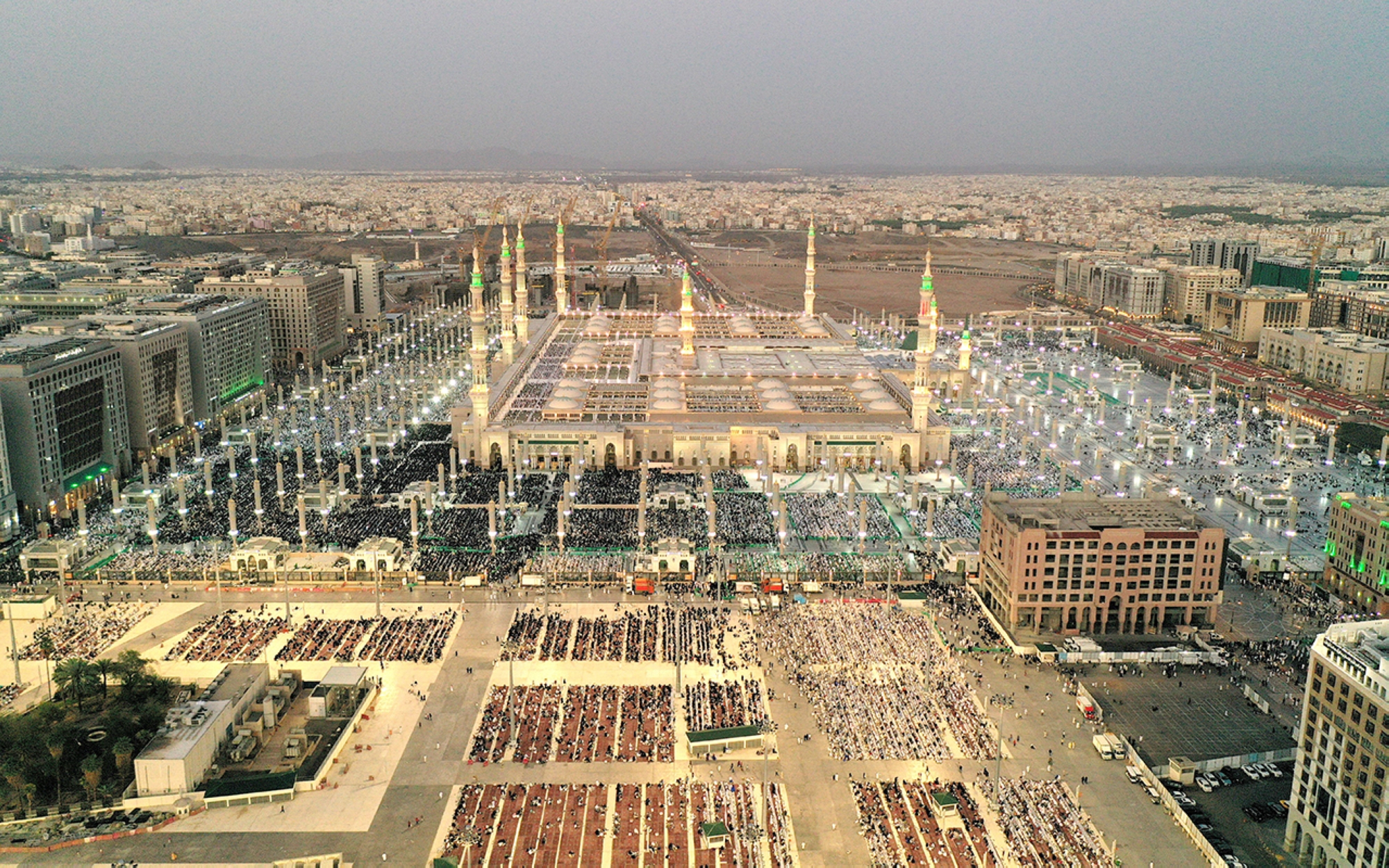
Efforts of the Kingdom in caring for the Prophet’s Mosque
The Prophet’s Mosque received great care from the Kingdom, as expansion, maintenance, and development activities extended from the era of the Founding King Abdulaziz Al Saud until this day. These activities include:
Caring for the old structure of the Prophet's Mosque
The Saudi government maintained and took care of the old structure of the Prophet’s Mosque, as part of its extended expansion activities. These involve preserving the mosque’s aesthetic appearance and all its elements, restoring the Holy Prophet's Mihrab, reinforcing and covering all the columns of al-Rawda al-Sharifa with new white marble, strengthening all the columns of the old structure, completing their copper bases, and installing copper fences around them at 2.5 m above the ground. Other operations include installing a central air-conditioning unit, covering the eastern, southern, and western facades with granite, and raising their level to match the elevation level of the expansion in a way that is consistent with the general appearance of the Saudi structure, in addition to repainting the inside of the mosque in beige in a way that is consistent with the interior appearance of the Saudi expansions, restoring the inscriptions and texts engraved on the domes and walls to preserve their beauty and splendor, restoring the main minaret and Bab al-Salam Minaret, opening a door in the southern eastern corner called Bab al-Baqi, opening a door from in the riwaq (portico) of the Qiblah that can be accessed by the imam, as well as worshipers during a funeral or when it is crowded, renewing the Green Dome’s paint whenever necessary, and installing new lamps and chandeliers. Until this day, restoration and maintenance operations are carried out on a daily basis.
Expansions
The first Saudi expansion was carried out by King Abdulaziz in 1949. The year 1953, marked the resumption of the expansion projects of the Prophet’s Mosque after they were halted for twelve centuries. The expansion covered an area of 6,024 m. During this expansion, buildings and houses located on the three eastern, western, and northern sides were purchased. Moreover, the northern part of the Sultan Abdulmejid building was removed due to its weak structure, and a new area that is adjacent to it was added, while the current southern section remained as is. Consequently, the Prophet’s Mosque covered an area of 16,548 m. During the reign of King Faisal Bin Abdulaziz, an order was issued to expand the Prophet’s Mosque in 1973, thus leading to the purchase of properties, houses, and residences west of the mosque, which were demolished after their ownership was expropriated and their owners were compensated. Then, they were replaced by domed canopies covering an estimated area of about 40,500 m, and equipped with the necessary utilities for prayer. During the reign of King Khalid, a fire broke out in the southwestern part of the mosque. The buildings located there were removed, and the property owners were compensated. These buildings were added to the courtyards of the Prophet’s Mosque, and an area of 43,000 m was shaded. With the increasing numbers of pilgrims, Umrah performers, and visitors and the need to expand the mosque, the second Saudi expansion was carried out by King Fahd Bin Abdulaziz. This expansion increased the mosque's area by approximately 82,000 m. It included the courtyards surrounding the Prophet’s Mosque, thus covering a total area of 235,000 m. This expansion is the greatest one in the history of the Prophet’s Mosque, not only because of its size and breadth, but also because of its strength, quality of construction, and availability of services and facilities. The third Saudi expansion was launched during the reign of King Abdullah Bin Abdulaziz in 2012 by evacuating and demolishing the properties inside the domain of the Mosque after compensating the owners. The properties were estimated at around one hundred, split between the eastern and western sides of the Prophet's Mosque. After its completion, the expansion would bring the Prophet's Mosque's area to 1,020,500 m including roofed squares and buildings. During the first phase of the third Saudi expansion, the capacity of the Prophet’s Mosque reached eight hundred thousand worshipers. In contrast, the second and third phases focused on expanding the external courtyards on the western and eastern sides around the Prophet's Mosque. During the reign of the Custodian of the Two Holy Mosques, King Salman Bin Abdulaziz Al Saud, an order was issued to complete the third Saudi expansion of the Grand Mosque and the Prophet’s Mosque.
Electronic services of the Prophet’s Mosque
The General Authority for the Affairs of the Two Holy Mosques was established to enable visitors to perform worship and rituals in a safe and pure environment, in addition to highlighting the bright global image of the Two Holy Mosques and showing the true values of Islam and Muslims. The General Directorate for the Affairs of Masjid Nabawi is one of the departments of the General Authority for the Affairs of the Two Holy Mosques. The directorate is responsible for all its religious and service affairs. Moreover, it enables visitors to perform worship and rituals, as well as achieve the scientific and advocacy mission of the Two Holy Mosques.
Manarat al-Haramain: This platform is an extension of a package of services launched by the General Directorate for the Affairs of Masjid Nabawi. It facilitates the provision of religious guidance and preaching, and enables visitors to access the related services of the Two Holy Mosques through seamless and high-quality digital platforms. The initiative - which was presented by the Ministry of Communications and Information Technology and the General Presidency for the Affairs of the Grand Mosque and the Prophet's Mosque (as it was previously called) - was launched to prevent the spread of COVID-19. Prayers were suspended in the Two Holy Mosques, resulting in the need to create a platform to broadcast the Friday sermon of the Two Holy Mosques, as well as the scientific lessons, sermons, lectures, and preachings. These steps complemented the efforts to spread knowledge, reach learners, and virtually enrich the realistic spiritual and devotional experience.
Suqiya Zamzam in the Prophet's Mosque
The Saudi government provides Zamzam water in the Prophet's Mosque by transporting it from filling stations in Makkah al-Mukarramah to the Zamzam tanks in the Prophet’s Mosque via tanks equipped with special specifications to protect water from any influences. A rate of three hundred t is transferred daily on normal days, while it reaches four hundred t in some seasons. Around fourteen thousand Zamzam refrigerated containers are placed in the Prophet’s Mosque and its courtyards, in addition to the (Sabeel Zamzam) site in the eastern courtyard of the Prophet's Mosque.
Related quizzes
Related articles


